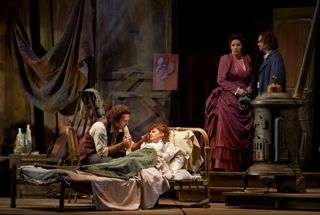|
Back
An artistic view of the artist’s life Toronto
The Four Seasons Centre for the Performing Arts
10/03/2013 - & October 6, 9, 12, 16, 18, 19, 22, 25, 27, 29, 30, 2013
Giacomo Puccini: La bohème
Grazia Doronzio (Mimi), Dimitri Pittas (Rodolfo), Joshua Hopkins (Marcello), Joyce El-Khoury (Musetta), Christian van Horn (Colline), Phillip Addis (Schaunard), Thomans Hammons (Benoît, Alcindoro), Owen McCausland (Parpignol), Gordon Bintner (Customs Officer), Clarence Frazer (Customs House Sergeant)
Canadian Opera Company Chorus, Sandra Horst (chorus master), The Canadian Children's Opera Company, Ann Cooper Gay (music director), Canadian Opera Company Orchestra, Carlo Rizzi (conductor)
John Caird (director), David Farley (set and costume designer), Michael James Clark (lighting designer)

D. Pittas, G. Doronzio, J. El-Khoury, J. Hopkins (© Michael Cooper)
This production of La Bohème is shared with the Houston Grand Opera (where it was seen in 2012 and reviewed on this website) and San Francisco Opera. John Caird’s production doesn’t offer a new view of the often- and well-told tale, but adds a twist with a focus on the fact that the bohemians are creative artists. As stipulated in the libretto, when the curtain rises we see the painter Marcello working on his “Red Sea” picture; we also see that the cluttered garret contains other paintings of his. Each of the work’s three scenes looks like an assemblage of his canvasses perhaps hastily pieced together for a production of the opera in a shabby old theatre with rumpled side and rear curtains. In the final moments of the last act the poet Rodolfo hastily scribbles something in his notebook while attending the dying Mimi; subsequently Marcello compulsively sketches while the stricken Rodolfo mourns the dead girl. The suggestion is that the artists have quickly assembled a stage work - composed no doubt by Schaunard - that recounts their recent life-changing experiences.
It is more than a little annoying that at two points the director’s ideas of stagecraft get in the way of the music and the drama. David Farley’s set is a marvel of scenic transformation: at the end of both Act I and Act III the set quickly splits apart and turns itself inside out to become, before our eyes, the following scene. Well done! - cinematic flow in an opera helps maintain the dramatic tension. However in each case the scene starts to change while the singers (Rodolfo and Mimi) are still singing - albeit offstage, which is just when they deserve our fullest concentration. The movement of the set triggers applause and thus we miss the evocative final notes of the two acts. I am surprised that someone with John Caird’s experience would miscalculate such important moments. (He has even written a book about stagecraft.) This is very easy to fix and would add no more than a minute to the running time.
On the musical side the star of the show is conductor Carlo Rizzi (this is no put-down of the singers). He gives due weight to small details throughout while keeping the overall musical arc solidly in place.
Grazia Doronzio is a cherishable Mimi in every way. Of course it helps that she is petite and winsome, but her voice has the mixture of sensitivity and strength that is ideal for the role. Many phrases are preceded by a slight hesitation making Mimi seem even more shy and vulnerable. Joyce El-Khoury, handling herself in a statuesque manner, is the perfect contrast to the fragile Mimi. She is also effective when Musetta must show her vulnerable side in the final act.
The four male bohemians, like the two women, are all youthful and each possesses the ideal physique du rôle for his part. Dimitri Pittas, in a welcome return to the COC, is an impassioned, restless Rodolfo. Joshua Hopkins is a fine Marcello; if his voice sometimes fails to be at the fore it is always there at the crucial moments. Phillip Addis is an animated Schaunard. Christian van Horn gets to show off his true basso notes (not always evident in the role) in Colline’s brief aria.
Thomas Hammons is perfect as both the seedy landlord, Benoît, and Musetta’s exploited, exasperated sugar daddy, Alcindoro.
Overall the direction is straightforward and clear. The Café Momus scene lacks a degree of sparkle, but this is in aid of the overall conceit that the sets are actually canvasses hastily created by Marcello.
The 12-performance run will see some interesting cast changes. Starting October 16 Michael Fabiano will assume the role of Rodolfo for four performances; Eric Margiore follows after him. Also on the 16th Joyce El-Khoury takes on the role of Mimi while Simone Osborne performs Musetta. Phillip Addis will take over the role of Marcello while Cameron McPhail steps in as Schaunard, and Tom Corbeil gets his turn as Colline. (Details at www.coc.ca.)
Michael Johnson
|